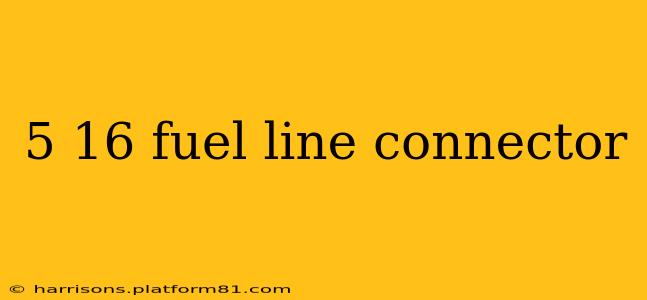Finding the right fuel line connector is crucial for vehicle safety and performance. A seemingly small component like a 5/16 fuel line connector can cause significant problems if not correctly identified and installed. This guide dives deep into understanding this specific connector, addressing common questions and providing valuable insights for mechanics, DIY enthusiasts, and anyone needing to repair or replace a fuel line.
What is a 5/16 Fuel Line Connector?
A 5/16 fuel line connector refers to a fitting used to connect fuel lines with an inner diameter of 5/16 of an inch. This measurement is critical, as using an incorrectly sized connector can lead to fuel leaks, a significant safety hazard. The connector's material is usually chosen for its fuel resistance and durability, commonly including materials like rubber, plastic, or metal. The type of connector (push-on, clamp, screw-on) also plays a significant role in the overall system's integrity and ease of installation.
What are the different types of 5/16 fuel line connectors?
Several types of 5/16 fuel line connectors exist, each designed for specific applications and fuel line materials. These can include:
- Push-on connectors: These are commonly used for fuel lines made of rubber or plastic. They are simple to install but might require specific tools for removal, ensuring a proper and secure connection.
- Clamp connectors: These offer a more secure connection, especially for high-pressure fuel systems. They typically require a hose clamp for tightening and ensuring a leak-proof seal.
- Screw-on connectors: These are often found in more robust fuel systems and offer a high degree of reliability and resistance to leaks. These connectors usually require specialized tools for installation and removal.
How do I identify the correct 5/16 fuel line connector?
Correctly identifying the right 5/16 fuel line connector involves several key steps:
- Measure the inner diameter: Accurately measure the inner diameter of your fuel line using a suitable caliper to confirm it's indeed 5/16".
- Check the connector type: Examine the existing connector to determine its type (push-on, clamp, screw-on). Matching the type is vital for ensuring proper installation and a reliable seal.
- Consider the material: The material of the connector should be compatible with the fuel type and the fuel line itself. Rubber and plastic connectors are common, but metal connectors offer increased durability in high-pressure applications.
- Check for any markings: Some connectors might have markings indicating their specific size, material, or manufacturer. Paying close attention to these markings can help in the identification process.
Where can I find a 5/16 fuel line connector?
5/16 fuel line connectors can be found at various automotive parts stores, both online and in physical locations. Checking with local auto parts stores or searching online retailers using the specifications (size, type, material) will yield the best results. Always ensure you are purchasing from reputable sources to guarantee the quality and safety of the connector.
What are the potential risks of using an incorrect connector?
Using an incorrect 5/16 fuel line connector can result in several serious issues, including:
- Fuel leaks: This poses a significant fire hazard, potentially leading to engine damage or even injury.
- Reduced fuel efficiency: A poorly connected fuel line can restrict fuel flow, causing a decrease in engine performance and fuel economy.
- Engine misfires or stalling: An intermittent fuel supply due to a faulty connector can cause the engine to misfire or stall.
How do I install a 5/16 fuel line connector?
Installing a 5/16 fuel line connector depends heavily on the specific type of connector being used. Consult the instructions included with the connector or seek professional help if unsure about the installation process. Remember that working with fuel lines requires caution and, if not confident, professional assistance is highly recommended. Fuel is flammable, and leaks can have severe consequences.
This comprehensive guide provides a strong foundation for understanding and selecting the appropriate 5/16 fuel line connector. Remember, precision and safety are paramount when working with fuel systems. Always prioritize safety and seek professional help if you are not comfortable with the task.
